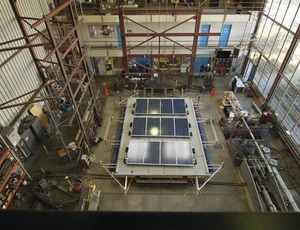
For the first time, a solar racking manufacturer tested its ballast-only roof-mounted racking system on U.C. Berkeley's Pacific Earthquake Engineering Research Center (PEER) shaking table in Richmond, Calif., and it appears to have passed with flying colors.
The March 5 test "provided us with information on how our roof mounting system acted [when] not connected to a roof," said Mike Williams, senior vice president-engineering for SunLink, San Rafael, Calif. The product "acted like we thought it would," he added.
SunLink has been teaming with engineering firm Rutherford and Chekene, San Francisco, on a series of seismic tests at PEER to calibrate and perfect proprietary seismic analysis models to improve the manufacturer's performance-based design. The team also tested wind-tunnel effects on rooftop solar arrays last year at the University of Western Ontario's Boundary Layer Wind Tunnel Laboratory.
Autodesk is also a partner in the program, which is being co-funded for nearly $1 million (with SunLink matching) by the California Solar Initiative Research, Development, Deployment and Demonstration program. The primary focus is on grid integration of solar energy, with a secondary focus on improved photovoltaic production technologies and business development and deployment. The California Public Utilities Commission is overseeing the $50-million, six-year state grant program.
The SunLink/Rutherford and Chekene project is called "Reducing California PV Balance of System Costs by Automating Array Design, Engineering and Component Delivery." Williams said the prevailing purpose is to lower roof installation costs, which grow dramatically when the systems are physically attached, and open up more installation work to general contractors and subcontrators, thus leading to a major expansion of solar use.
SunLink said building officials in California almost always require direct mechanical connection of PV systems to flat roof structures in order to prevent shifting during an earthquake, even though engineering analysis and design based on code criteria demonstrate that systems perform well without such anchoring. Building code officials also are influenced by the International Building Code's fastening requirements. Once the codes are adjusted, the permitting process should be easier.
The most recent test, which measured movement from the roof of a three-story office building, utilized seismic motion from the 1989 Loma Prieta Earthquake in three sequences: a 200-, 500- and 1,000-year event. Peak roof acceleration ranged from 0.65g to 1.95g. SunLink's CORE RMS model mounting system sits on rubber feet made from recycled tires (each foot eliminates two tires from landfills). The CORE model, according to SunLink, features a sturdy grid assembly that provides strength and load distribution for framed or laminate installations of 10 degrees or less. Projects can be installed with whatever custom row space is optimal given module size and energy production requirements.
The results will be distributed via reports to the California Solar Initiative and industry journals. Williams said the results will be used to validate and calibrate non-linear computer analysis models as well as influence the creation of new structural standards.

Post a comment to this article
Report Abusive Comment